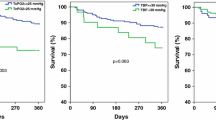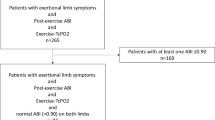Abstract
Purpose
To assess postprocedural angiograms, the ankle–brachial index (ABI), and transcutaneous oxygen tension (TcPO2) to predict outcome after infrageniculate angioplasty (PTA) in diabetic patients with critical limb ischemia (CLI) scheduled for amputation.
Materials and Methods
PTA was performed in 28 diabetic patients with CLI confined to infrapopliteal vessels. We recorded patency of crural vessels, including the vascular supply of the foot as well as the ABI and TcPO2 of the foot.
Results
Technical success rate was 92.9% (n = 26), and limb-salvage rate at 12 months was 60.7% (n = 17). The number of patent straight vessels above and below the level of the malleoli increased significantly in patients avoiding amputation. Amputation was unnecessary in 88.2% (n = 15) patients when patency of at least one tibial artery was achieved. In 72.7% (n = 8) of patients, patency of the peroneal artery alone was not sufficient for limb salvage. ABI was of no predictive value for limb salvage. TcPO2 values increased significantly only in patients not requiring amputation (P = 0.015). In patients with only one tibial artery supplying the foot or only a patent peroneal artery in postprocedural angiograms, TcPO2 was capable of reliably predicting the outcome.
Conclusion
Below-the-knee PTA as an isolated part of therapy was effective to prevent major amputation in more than a half of diabetic patients with CLI. TcPO2 was a valid predictor for limb salvage, even when angiographic outcome criteria failed.




Similar content being viewed by others
References
Faglia E, Clerici G, Caminiti M et al (2010) Mortality after major amputation in diabetic patients with critical limb ischemia who did and did not undergo previous peripheral revascularization: Data of a cohort study of 564 consecutive diabetic patients. J Diabetes Complications 24:265–269
TransAtlantic Inter-Society Consensus (2000) Management of peripheral arterial disease (PAD). TransAtlantic Inter-Society Consensus (TASC). Section D: Chronic critical limb ischaemia. Eur J Vasc Endovasc Surg 19(Suppl A):144–243
Norgren L, Hiatt WR, Dormandy JA et al (2007) Inter-society consensus for the management of peripheral arterial disease (TASC II). Eur J Vasc Endovasc Surg 33(Suppl 1):1–75
Ameli FM, Byrne P, Provan JL (1989) Selection of amputation level and prediction of healing using transcutaneous tissue oxygen tension (PtcO2). J Cardiovasc Surg (Torino) 30:220–224
Fife CE, Smart DR, Sheffield PJ et al (2009) Transcutaneous oximetry in clinical practice: consensus statements from an expert panel based on evidence. Undersea Hyperb Med 36:43–53
Caruana MF, Bradbury AW, Adam DJ (2005) The validity, reliability, reproducibility and extended utility of ankle to brachial pressure index in current vascular surgical practice. Eur J Vasc Endovasc Surg 29:443–451
Faglia E, Dalla PL, Clerici G et al (2003) Peripheral angioplasty as the first-choice revascularization procedure in diabetic patients with critical limb ischemia: prospective study of 993 consecutive patients hospitalized and followed between 1999 and 2003. Eur J Vasc Endovasc Surg 29:620–627
Pecoraro RE, Reiber GE, Burgess EM (1990) Pathways to diabetic limb amputation. Basis for prevention. Diabetes Care 13:513–521
Adler AI, Boyko EJ, Ahroni JH et al (1999) Lower-extremity amputation in diabetes. The independent effects of peripheral vascular disease, sensory neuropathy, and foot ulcers. Diabetes Care 22:1029–1035
Kalani M, Brismar K, Fagrell B et al (1999) Transcutaneous oxygen tension and toe blood pressure as predictors for outcome of diabetic foot ulcers. Diabetes Care 22:147–151
Grolman RE, Wilkerson DK, Taylor J et al (2001) Transcutaneous oxygen measurements predict a beneficial response to hyperbaric oxygen therapy in patients with nonhealing wounds and critical limb ischemia. Am Surg 67:1072–1079
Fife CE, Buyukcakir C, Otto GH et al (2002) The predictive value of transcutaneous oxygen tension measurement in diabetic lower extremity ulcers treated with hyperbaric oxygen therapy: a retrospective analysis of 1,144 patients. Wound Repair Regen 10:198–207
Greenhalgh DG, Warden GD (1992) Transcutaneous oxygen and carbon dioxide measurements for determination of skin graft “take”. J Burn Care Rehabil 13:334–339
Misuri A, Lucertini G, Nanni A et al (2000) Predictive value of transcutaneous oximetry for selection of the amputation level. J Cardiovasc Surg (Torino) 41:83–87
Faglia E, Clerici G, Caminiti M et al (2007) Predictive values of transcutaneous oxygen tension for above-the-ankle amputation in diabetic patients with critical limb ischemia. Eur J Vasc Endovasc Surg 33:731–736
Caselli A, Latini V, Lapenna A et al (2005) Transcutaneous oxygen tension monitoring after successful revascularization in diabetic patients with ischaemic foot ulcers. Diabet Med 22:460–465
Manzi M, Fusaro M, Ceccacci T et al (2009) Clinical results of below-the knee intervention using pedal-plantar loop technique for the revascularization of foot arteries. J Cardiovasc Surg (Torino) 50:331–337
Markose G, Bolia A (2009) Below the knee angioplasty among diabetic patients. J Cardiovasc Surg (Torino) 50:323–329
Tsetis D, Belli AM (2004) The role of infrapopliteal angioplasty. Br J Radiol 77:1007–1015
Wang J, Zhu YQ, Zhao JG et al (2009) Infrapopliteal angioplasty with a long over-the-wire (OTW) balloon in the treatment of severe limb ischemia in diabetic patients: a retrospective study. Acta Radiol 50:360–367
Alfke H, Vannucchi A, Froelich JJ et al (2007) Long-term results after balloon angioplasty of the crural artery. Rofo 179:811–817
Dormandy JA, Rutherford RB (2000) Management of peripheral arterial disease (PAD). TASC Working Group. TransAtlantic Inter-Society Consensus (TASC). J Vasc Surg 31:1–296
Conrad MF, Kang J, Cambria RP et al (2009) Infrapopliteal balloon angioplasty for the treatment of chronic occlusive disease. J Vasc Surg 50:799–805
Schwarzwalder U, Zeller T (2009) Below-the-knee revascularization. Advanced techniques. J Cardiovasc Surg (Torino) 50:627–634
Gandini R, Volpi T, Pampana E et al (2009) Applicability and clinical results of percutaneous transluminal angioplasty with a novel, long, conically shaped balloon dedicated for below-the knee interventions. J Cardiovasc Surg (Torino) 50:365–371
Faglia E, Mantero M, Caminiti M et al (2002) Extensive use of peripheral angioplasty, particularly infrapopliteal, in the treatment of ischaemic diabetic foot ulcers: clinical results of a multicentric study of 221 consecutive diabetic subjects. J Intern Med 252:225–232
Met R, Koelemay MJ, Bipat S et al (2010) Always contact a vascular interventional specialist before amputating a patient with critical limb ischemia. Cardiovasc Intervent Radiol 33:469–474
Bargellini I, Petruzzi P, Scatena A et al (2008) Primary infrainguinal subintimal angioplasty in diabetic patients. Cardiovasc Intervent Radiol 31:713–722
Randon C, Jacobs B, De Ryck F et al (2010) Angioplasty or primary stenting for infrapopliteal lesions: results of a prospective randomized trial. Cardiovasc Intervent Radiol 33:260–269
Bull PG, Mendel H, Hold M et al (1992) Distal popliteal and tibioperoneal transluminal angioplasty: long-term follow-up. J Vasc Interv Radiol 3:45–53
Bakal CW, Sprayregen S, Scheinbaum K et al (1990) Percutaneous transluminal angioplasty of the infrapopliteal arteries: results in 53 patients. Am J Roentgenol 154:171–174
Brown KT, Moore ED, Getrajdman GI et al (1993) Infrapopliteal angioplasty: long-term follow-up. J Vasc Interv Radiol 4:139–144
Ubbink DT, Spincemaille GH, Reneman RS et al (1999) Prediction of imminent amputation in patients with non-reconstructible leg ischemia by means of microcirculatory investigations. J Vasc Surg 30:114–121
Kuusela J, Manninen HI, Karhapää P (2009) Infrapopliteal balloon angioplasty for chronic critical limb ischemia in diabetic patients with uremia: when is it worth the effort? J Vasc Interv Radiol 20:342–346
Slovut DP, Sullivan TM (2008) Critical limb ischemia: medical and surgical management. Vasc Med 13:281–291
Hanna GP, Fujise K, Kjellgren O et al (1997) Infrapopliteal transcatheter interventions for limb salvage in diabetic patients: importance of aggressive interventional approach and role of transcutaneous oximetry. J Am Coll Cardiol 30:664–669
Conflicts of interest
There are no conflicts of interest.
Author information
Authors and Affiliations
Corresponding author
Rights and permissions
About this article
Cite this article
Redlich, U., Xiong, Y.Y., Pech, M. et al. Superiority of Transcutaneous Oxygen Tension Measurements in Predicting Limb Salvage After Below-the-Knee Angioplasty: A Prospective Trial in Diabetic Patients With Critical Limb Ischemia. Cardiovasc Intervent Radiol 34, 271–279 (2011). https://doi.org/10.1007/s00270-010-9968-x
Received:
Accepted:
Published:
Issue Date:
DOI: https://doi.org/10.1007/s00270-010-9968-x




